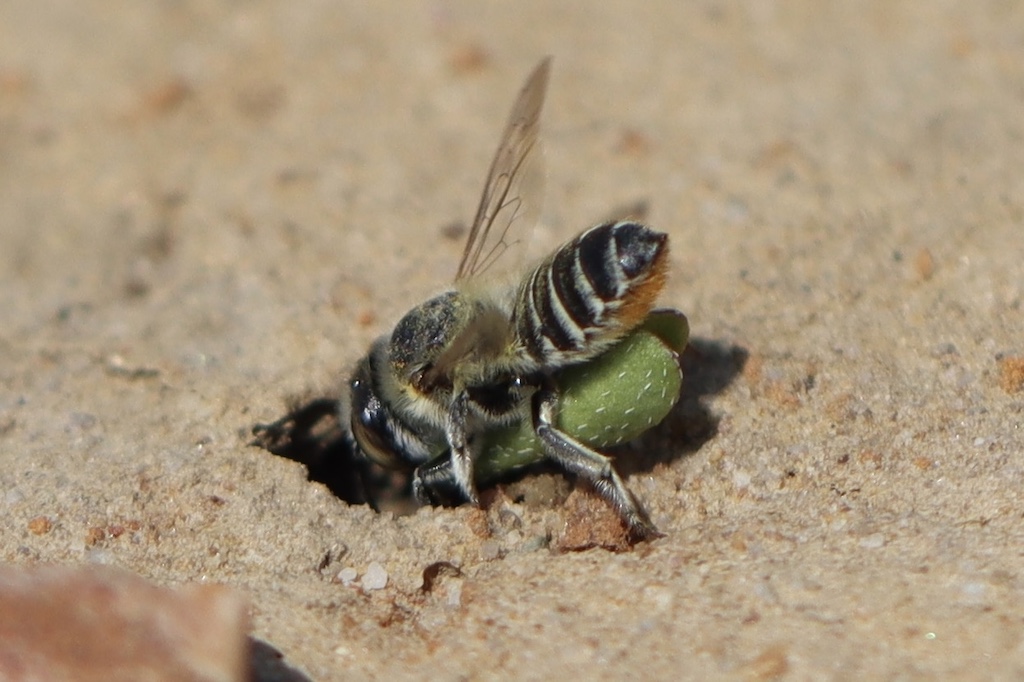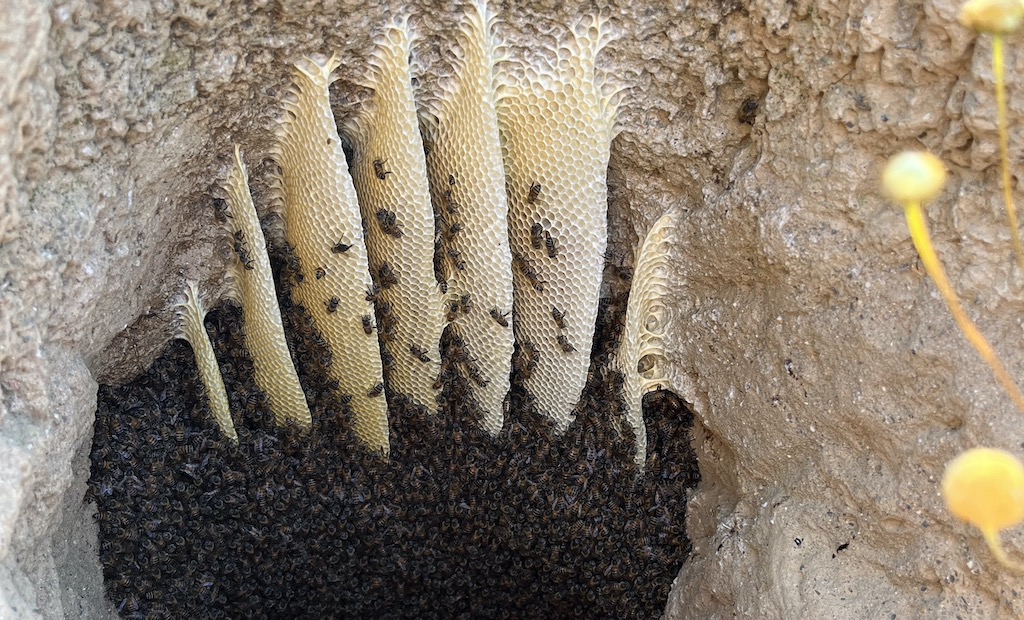
Should we keep bees?
Arid to semi-arid environments are surprisingly rich in bee diversity. When most people think of bees, they often picture the honeybee (Apis mellifera). However, the reality is far more complex. Globally, there are over 23,000 bee species, the majority of which are solitary rather than social, as seen in honeybee colonies. In these solitary species, each female constructs her own nest, gathers pollen and nectar to provision her young, and lays her eggs before her brief life of sometimes just 6 to 8 weeks comes to an end. Each season often hosts its own unique bee species. This contrasts with honeybees, which remain active throughout the year in most regions of South Africa. Many of the solitary bees have co-evolved together with the flora of each region. This intricate tapestry of adaptation and survival has unfolded over millennia, leading to a remarkable diversity that thrives even in the harsh climates of areas like the Karoo. It’s astonishing to think that such diversity exists in seemingly desolate landscapes.

As I observe the bees at Wolwekraal Nature Reserve in the arid Karoo, I often feel a sense of urgency; there simply aren’t enough hours in the day to document the incredible ecology and behaviour of solitary bees currently emerging with the spring flowers. In SA we have over 1300 species of solitary bees, but many remain to be both discovered and described. So little is known about them.
Wolwekraal is a paradise for bees, but bees don’t thrive in isolation. Their presence also transforms Wolwekraal into a haven for all life that relies on them. As examples of what exists, for the past three weeks I have been engrossed in a bare patch of hardened ground surrounded by vygies, daisies, and other typical Karoo flora. Currently annuals like Gazania lichtensteinii are flowering in swathes of yellow. At first glance this sandy deflation hollow appears desolate. But I have been incredulous at the life on it! It is home to a nest aggregation of solitary bees. I counted 114 nests in just twelve square metres. The males hatch first, engaging in frantic competition to mate with the newly emerging females. Once mated, she flies off in search of a new nest site and begins her foraging for pollen and nectar to start reproducing and to ensure the survival of future generations.

The abandoned nests are then repurposed by other solitary bees, such as those in the Osmiine tribe, which includes leaf-cutting, mason, and resin bees. These female bees utilise diverse nesting techniques, often lining their burrows with remarkable reddish-pink pulp made from chewed plant material. Others use leaves and petals to construct thimble-like chambers. After foraging for nectar and pollen on flowers close by, each burrow is meticulously sealed with a mixture of sand, tiny stones or leaves, and a secretion from a special gland. Some even place stones on top for additional protection. Once her work is complete, the female dies, leaving her young to develop underground until they hatch in a year, if conditions are right.


However, the nests are not always safe from other threats. Wingless velvet ants (a kind of wasp) are able to push out the stones and lay eggs within. Moreover, bee-flies can parasitise open nests, further complicating the lives of solitary bees. Amidst this all, balbyter ants carry off any organic debris, frantic surface beetles and sand lizards scurry by, grasshoppers leap across the terrain, and robber flies, birds and barking geckos are all in the neighbourhood.
Beyond this deflation hollow, I discovered an extraordinary mud nest in the shallow of a stone. A bee known as Chalicodoma builds her nest in a hollow in a rock sealed over by sand cemented with a secretion from her mouth. And just a short distance away, along the ancient riverbank of the Dorps, exists another active bee nesting site with a multitude of bee nests; here root and burrow fossils create extraordinary patterns between nest entrance holes. This is merely a glimpse into the myriad stories waiting to be uncovered at Wolwekraal.

Many aspects in nature remain undocumented. For example, the fly I filmed parasitising the solitary bee nests may represent a new host record. Some solitary bee species are highly specialised, acting as the sole pollinators for specific flower species. This fragile interplay highlights the delicate nature of plant-pollinator relationships. Our landscapes are vastly under-documented, and with many species facing extinction due to habitat loss and human encroachment, we must act quickly to better understand and protect these vital ecosystems.
Wild honeybees are equally fascinating, and again so little is known about them. In most places honeybees have become a commodity and are typically associated with hives (and honey), and traded as pollination units. In South Africa, fortunately, more than 90% of honeybee colonies remain wild residing in natural habitats. Contrary to common belief, we have no shortage of bees. This natural abundance fosters adaptation in micro-habitats, and to changing environments and climates. In both our solitary bees and wild honeybees, SA has a huge natural pool of excellent pollinators. In Europe, most wild honeybee populations have been lost, with the majority of western European nations seeing almost total domestication and hybridisation of their once indigenous honeybee species. As a result, many colonies succumb annually to disease and other stressors. In contrast, wild honeybees in their natural cavities create habitats conducive to survival. Their use of abundant, local, site-specific plant resins, mostly in the form of propolis, and their interactions with many other creatures, organisms and microbes within the nest, is what keeps their environment healthy.

Human activity can disrupt this delicate balance. Introducing hives to a new area can drastically alter the local ecosystem. A single hive can house up to 60,000 bees, all of which require substantial amounts of forage to thrive. The ecological consequences can be severe, especially when unaware of the existing species. Besides the risk of disease and microbial shifts, and the introduction of different strains of honeybees into an area, honeybees can outcompete solitary bees for nectar and pollen, further stressing already vulnerable populations. Wild honeybees living naturally in an area are equally affected by such increases in honeybee numbers. During periods of extreme heat or drought, wild honeybees can enter a state of dormancy, relying on stored honey to survive. It’s been suggested that the number of wild honeybee colonies in an area is limited by the worst month for forage availability.
Nature possesses a remarkable intelligence and a fragile balance that we must strive to protect. We should be cautious not to unintentionally contribute to ecological loss through changes like hive introductions in finely tuned environments. Instead, by planting indigenous flowers and veld types and allowing some areas of our gardens to remain wild, we can invite nature in and help create vibrant ecosystems. Just as Wolwekraal serves as a unique ‘laboratory’ for observing nature, our gardens can also become spaces for wild bees and other creatures, revealing the wonders of biodiversity season after season, and allowing us all to become bee-keepers of a different kind. Who knows what bees we may yet discover.



Wonderful and fascinating info.
Living in karoo for many years we learnt to appreciate nature and its inter action